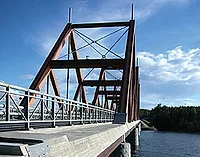Waterborne Primers Providing the Base for Exceptional Topcoat Performance

A universal architectural primer coating serves two main functions. The first is to enhance the ability of a topcoat to beautify the substrate. This is achieved by hiding topographic variations and optical variations. The second main function is adding durability to extend the life of the topcoat. This is primarily achieved by improving adhesion, which can lead to better crack and blister resistance. Enhanced durability is also promoted by the primer forming a barrier layer to improve corrosion, nail rust and flash rust resistance.
Despite the need for a primer to be somewhat of a universal product, the primer market is actually heavily segmented. Critical performance needs include hiding topographic variations, sealing porous substrates, preventing old colors from showing through the topcoat, odor blocking, providing a good tie coat layer between the substrate/topcoat, extending exterior durability, and reducing stains from migrating into the topcoat. Odor-blocking primers typically aim to block persistent odors that come from cigarette smoke, pets and food. Primers are used on a wide variety of substrates such as glossy alkyd, steel, aluminum and wood, so they must demonstrate exceptional adhesion across all surfaces. Primers are also promoted for exterior durability, so it is critical that they demonstrate excellent crack resistance, corrosion resistance and adhesion. Common problematic stains that waterborne primers have difficulty blocking include wood tannins, markers, food stains, water damage and nicotine from cigarettes. From this list alone, it should be obvious why each major manufacturer has at least 10 primer product lines, each targeting a specific need. In addition to these performance needs, the market is further segmented into various label claims including fast drying, multipurpose, stain killing, mold killing and odorless, just to name a few.
There have not been many new developments in primers in recent years other than a continued shift from solvent-based to lower volatile organic compound (VOC) water-based technologies. In a California Air Resources Board report, R. Fernando found that “solvent-based coatings perform significantly better than waterborne coatings” [for stain blocking].1 However, solvent-based primers typically have high VOC levels, high odor, and are difficult and messy to clean up. These reasons have prompted a movement to waterborne primers, but ideally still maintaining the stain-blocking properties of solvent-based primers. With the change from solvent to water comes a different mechanism to hide stains – instead of stain blocking, waterborne primers are stain locking. This article will focus on the stain-blocking and locking mechanisms, next-generation primer stain-blocking capabilities, and a discussion on the benefits of using a primer with a topcoat with real-world exposure data.
Stain-Blocking and Locking Mechanisms
The mechanism by which primers block stains depends on whether they are water-based or solvent-based. A solvent-based primer when painted over a stain visually blocks the stain without the topcoat, which we refer to as stain blocking. A water-based primer locks the stain in the film, and only when the topcoat is applied do you receive the desired visual hiding of the stain. Figure 1 shows common food and ink colorants, and tannin stains.

Oil-based primers are solutions of alkyd resins that are dissolved in solvent. They work very well on hiding extremely hydrophilic stains. The wet paint and the dry film are both very hydrophobic, so common water-soluble stains are insoluble in the wet primer film, thus retarding the stains’ diffusion into the primer. As a result, the solvent-based primer gives one-coat stain blocking at the substrate/primer surface, and the stain cannot be seen. The downsides are the high odor, high VOC (typically above 300 g/L) and messy clean up. Also, flammable solvents are required to clean up the solvent-based primers. Regulators, businesses and homeowners all wish to avoid their use whenever possible.
Water-based primers do have some advantages over solvent-based products, including low VOC, low odor and easier clean up, which is much more appealing to both contractors and do-it-yourself painters. Waterborne primers also demonstrate better exterior durability because oil-based primers continue to crosslink over time, leading to more brittle coatings and increased cracking failures. The major disadvantage to waterborne primers is that some stains can be difficult to block or hide. This is because water-based stains are immediately solubilized in the wet film as soon as the primer is applied and consequently need to be locked into the dry primer film. The primer does not hide the stain, and an additional coat may be needed to visually block the stain. Additionally, as another coat of paint is applied, the stain can re-solubilize and come to the surface of the second coat of paint. There are ways to avoid this, such as by adding in functional pigments. This will be discussed in more detail later in this section.
Furthermore, waterborne primers are made with emulsion particles that must coalesce to form a film, as shown in Figure 2 (not drawn to scale). In stage A, the pigment and binder particles are dispersed in water. The water begins to evaporate as the film dries (B) and the particles are packed closer together. In stage C, the binder particles fuse into a continuous film in which the pigment particles are “trapped”. This coalescence process allows more channels through the film than for oil-based alkyd primers where the hydrophobic carrier minimizes migration of the hydrophilic stains. The higher the pigment volume concentration (PVC) of the primer, the more the pigment can interfere with the film-forming process, leaving channels for stains to migrate through. Thus, blocking and locking of stains becomes more difficult at higher PVC primers. This in turn can lead to inferior stain blocking of waterborne primers.
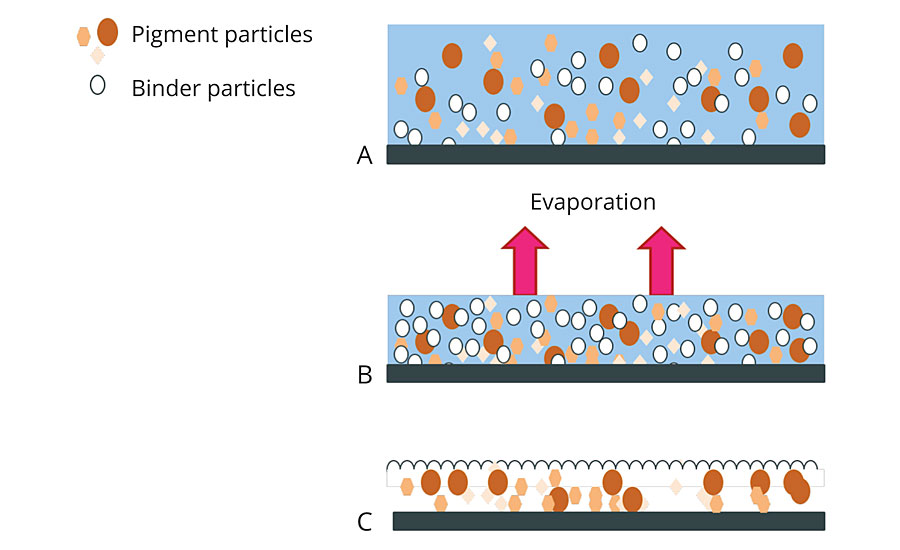
As previously mentioned, there are functional pigments and other additives that can improve the stain-blocking ability of waterborne primers. Several technologies have been proposed in the literature, but the most commonly implemented one is the use of zinc oxide (ZnO). The zinc cations react with the anionic stains and are therefore able to minimize the stain leaching into the topcoat. Figure 3 shows a generic picture of this mechanism. Other proposed technologies include use of water-dispersible alkyd resin with a tannin chelating agent,2 use of polyvinylpyrrolidone3 and cationic resins.4
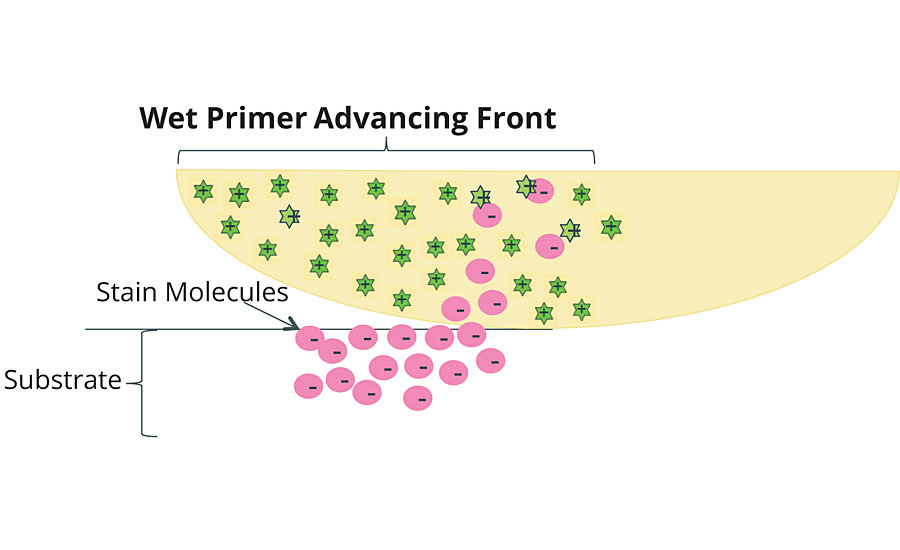
While ZnO is most commonly used to improve stain blocking in waterborne primers, it is not the most user-friendly material when formulating paints. Due to its cationic nature, it has the ability to react with the many other anionically dispersed materials in the paint, which can lead to gel, viscosity instability or other problems. It requires the use of additional dispersants and/or surfactant to stabilize, but these often negatively impact water resistance properties that are key primer properties. Also, ZnO is not very environmentally friendly. The Dow Chemical Company (Dow) has been able to synthesize a next-generation waterborne primer binder that can improve stain blocking without the use of ZnO. In addition to excellent tannin and marker stain blocking, the next-generation primer binder offers good adhesion to a variety of substrates, excellent sandability and is ultralow-VOC capable.
Next-Generation Primer Stain-Blocking Performance
When evaluating primer performance in the lab, the two primary stain-blocking tests that are performed are tannin and marker. For tannin stain blocking, a cedar or redwood board is used, preferably one with consistent staining across the entire panel. A series of primers are applied at a spread rate of 450 square feet/gallon, allowed to dry for 2 hrs, then a premium flat topcoat5 is applied over the entire board. Because of board-to-board variation, every series must include both a pass control (oil-based) primer and a fail control (flat topcoat) primer. The board is then immediately placed painted side up into a high-humidity fog box overnight. The panel is removed and then measured quantitatively using a spectrometer after various drying intervals. Figure 4 shows the next-generation Dow primer formulated without ZnO against a variety of commercial paints and Dow paints, all formulated without ZnO. This demonstration clearly shows that excellent tannin stain blocking can be achieved without ZnO using waterborne technology. The tannin stain blocking is even comparable to the commercial oil-based pass control primer, which sets the bar for stain-blocking performance.
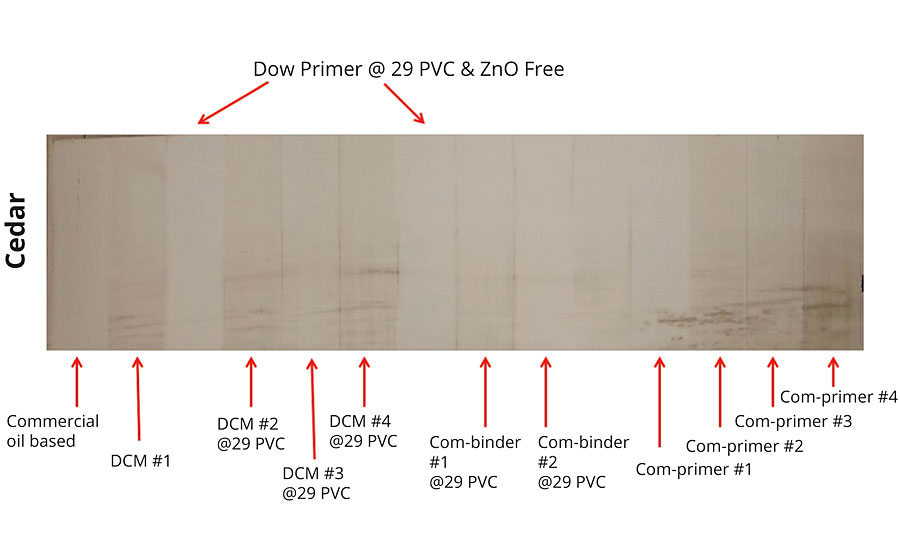
When testing marker stain blocking, a variety of hydrophobic and hydrophilic markers are used. Markers are applied to a one-week-old dried premium flat paint (same 46 PVC/37 VS used for tannin blocking) on a Leneta chart and then allowed to dry in a drawer for several days to avoid any light. Two primers are applied by drawdown bar side by side across the marker lines on the chart. After drying 4 hrs, a narrower drawdown of the premium flat paint is applied over the primer. Finally, an even narrower-width second coat of the flat paint is applied. The chart is evaluated both visually on how much marker is observed through the thickest coated part of the chart and additionally with image capture software that quantifies the standard deviation within a defined region for each marker. Again, the next-generation technology demonstrates significant improvement in stain blocking, as shown in Figure 5.
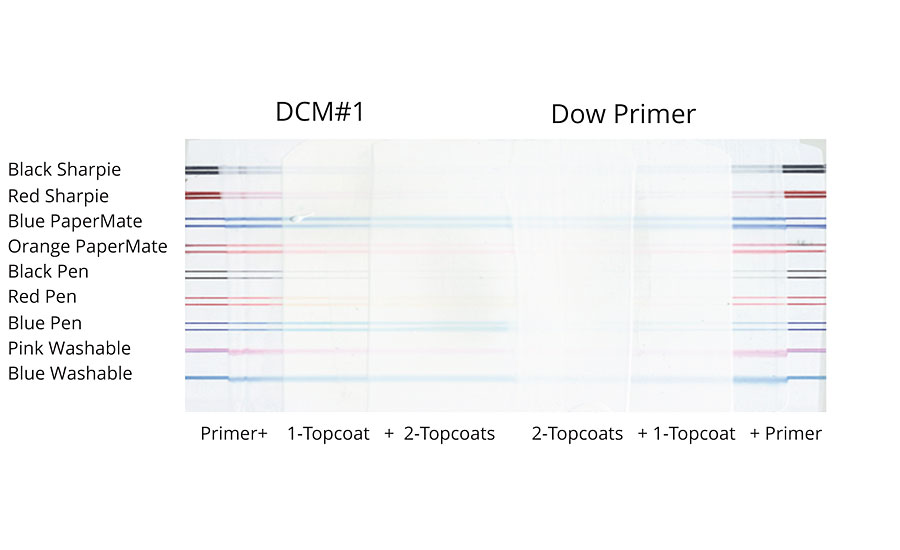
Exterior Primer Performance
As previously mentioned, the job of a primer is to enhance the topcoat’s ability to beautify the substrate and extend the life of the topcoat by adding durability. The following section will demonstrate how primers perform in real-world exposures, which offer the most convincing exterior paint performance data. While Dow has many global exposure sites for exterior testing, the site in Spring House, Pennsylvania, offers a very challenging environment due to the change in seasons and the high number of freeze/thaw cycles experienced each winter. While areas in New England and the Midwest may stay colder for longer periods of time in the winter, the temperature at the exposure station in Spring House dips above and below freezing many times throughout the winter months, which can prove challenging for a paint film. There are numerous substrates available at the exposure station, including many different types of wood, masonry, concrete, composite decking and metal substrates. Paints are exposed in different directions, including South Vertical (SV), North Vertical (NV) and South 45˚ (S45), with each direction accelerating a paint failure. For example, paints exposed at NV will demonstrate accelerated mildew and mold growth due to water retention.
One of the more challenging substrates for crack resistance is pine due to its inherent dimensional instability. Figure 6 demonstrates the significant benefit of using a primer with topcoat after 24 months on white pine. The coatings in Figure 6 are divided into three pairs. The first coating in each pair consists of two applications of topcoat; the second coating in each pair consists of a primer and only one topcoat. The topcoats include an economy commercial flat paint based on a terpolymer (Paint 1), a better-quality commercial flat paint based on a polyvinyl alcohol (PVA) resin (Paint 3), and a moderate-quality laboratory-formulated paint formulated with an all-acrylic resin (Paint 7). The primer was a durable, all-acrylic formulation (Paint 5). The paint numbers can be seen on the top of each section of paint, with 1|1 indicating two coats of Paint 1 and 1|5 indicating one coat of Paint 5 (the primer) and one coat of Paint 1. When applied without primer, none of the commercial paints perform well, with all three showing significant cracking and flaking. Despite being used in only a moderate-quality formulation, the paint with the all-acrylic binder demonstrated better performance with no primer than the other commercial paints. However, it is clear that use of the primer improves the crack resistance of all of the topcoats. After 24 months exposure, the second paint in each pairing, where a primer was used, is showing very little cracking and flaking.
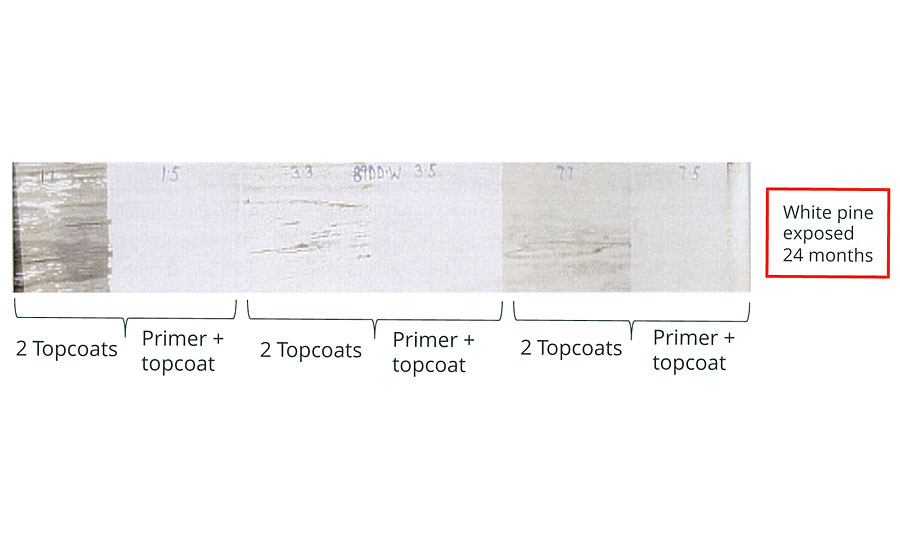
Figures 7 and 8 show real-world exposure data over time. As mentioned, pine is a very difficult substrate for crack and flake resistance due to its dimensional instability. Even more challenging is weathered pine, which has been exposed to the natural elements (water, ultraviolet light, temperature fluctuations) for three months prior to being painted. Over decades of exposure data, it has been determined that once the Crack or Flaking rating falls below 80, the failures have become very visually obvious. In Figure 7, the paint with no primer reaches that threshold in just 20 months, while the paints with primer are still performing well at five years and beyond. Similarly, the flaking rating of the paint with no primer falls below 80 at ~35 months, while the other two paints plus primers are still performing well at 60+ months. Figure 9 shows pictures of the same topcoats from Figures 7 and 8 over the weathered yellow pine with and without use of a primer after 58 months of exposure. It should be extremely clear from these figures that using a primer protects the topcoat and extends the life of the paint.
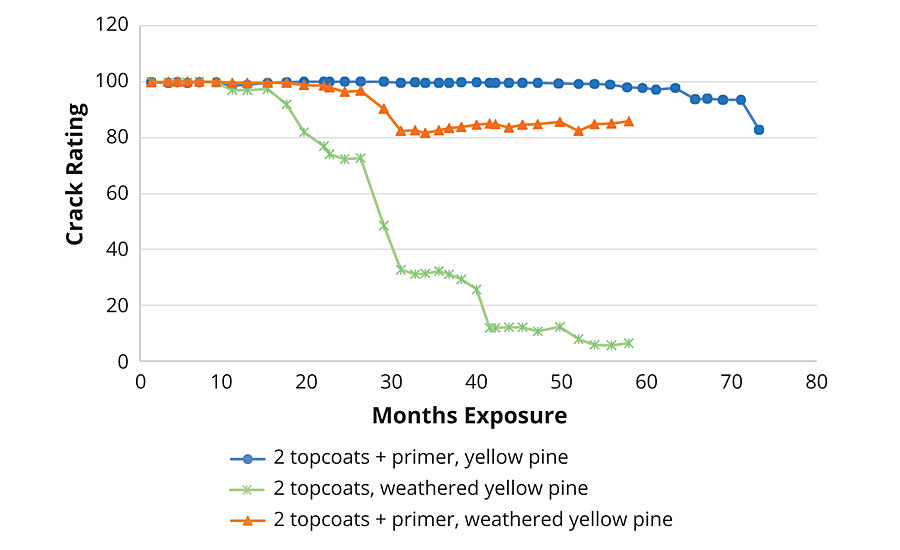
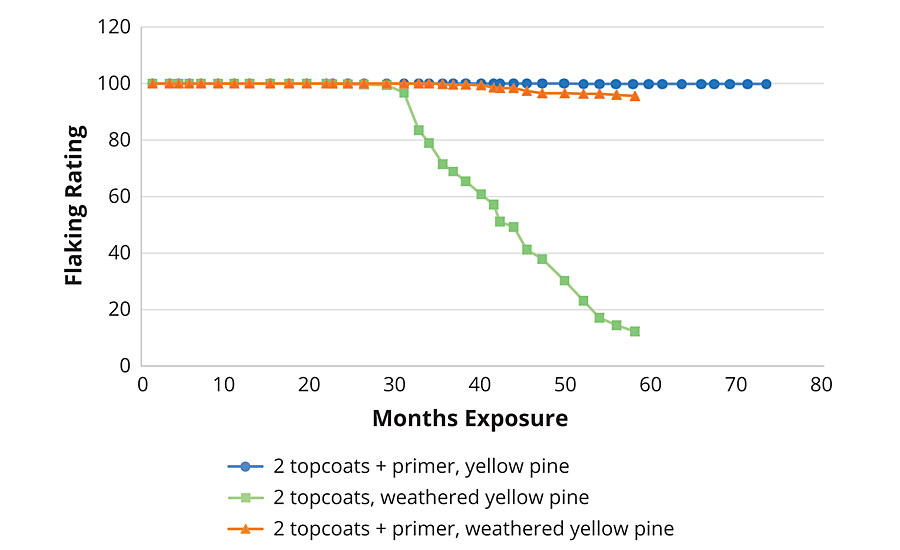
In the early 2010s a new primer technology entered the market and was a popular choice with do-it-yourselfers – the paint and primer-in-one product line. Paint manufacturers claimed that these paints eliminated the need for a primer coat, thus decreasing the time a homeowner needed to spend on painting. Other claims from these types of paints included catch phrases such as one-coat hide, self-priming, great hide and one-coat coverage, again targeting the homeowner trying to save both time and money. Dow has many exposure series at the Spring House exposure station that include top-of-the-line commercial paint and primer-in-one paints in addition to lab-made primer painted out with topcoats. Similar to the paint performance in Figures 7 and 8, use of a primer with a topcoat demonstrates superior performance for crack and flake resistance as compared to the commercial paint and primer-in-one products. Figure 10 shows the performance of these paints over time on 3-month weathered yellow pine. Paints 6-9 are two coats of commercial paint and primer-in-one products, while Paint 10 is a lab-made topcoat over primer (paint 21). As mentioned previously, once the rating falls below 80, the failures are visually very obvious. The primer and topcoat system is still higher than that threshold after 5 years for flake resistance, while the commercial paints fall below 80 in only 2-3 years.
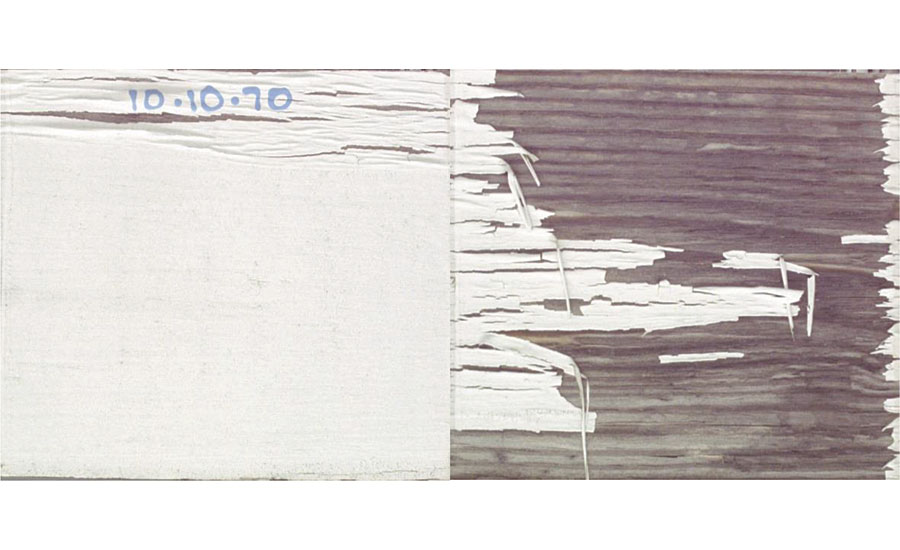

Another substrate that is commonly used at the Spring House exposure station is nail head boards, in which a grid of 20 nails is hammered into each panel. These substrates are used to evaluate incidental metal rust resistance. A nail head exposure series is shown in Figure 11. Each section was primed with different primers and coated with the same commercial topcoat, and no flash-rust was observed with any of the coatings when they were originally put out on exposure. The vertical section to the right highlighted by the red box was coated with two coats of topcoat and no primer. After over four years on exposure, it is obvious that the primers used in the second column help with rust resistance. Additionally, it is also clear that not all primers are created equal, as noted by several showing virtually no rust and excellent dirt pick-up resistance, while others perform no better than two topcoats.
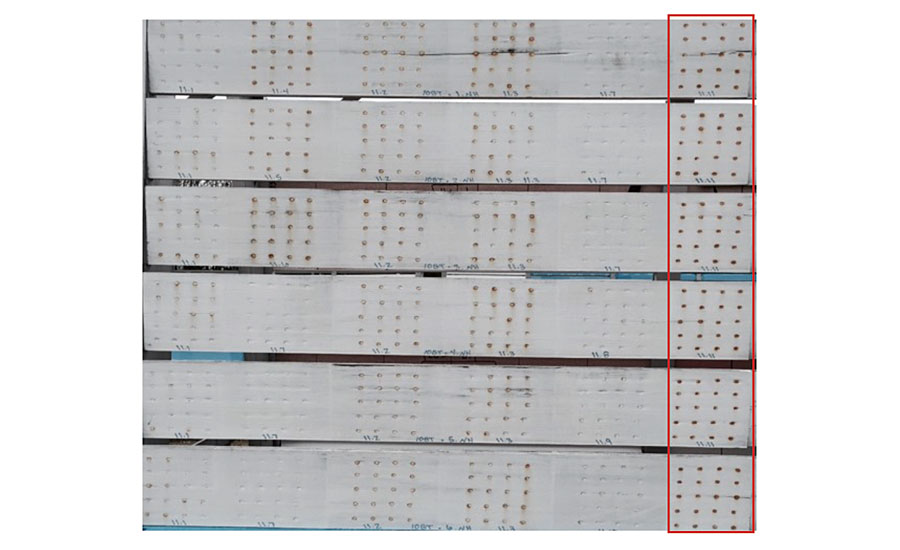
The first section of this paper discussed the performance benefits of oil-based primers versus waterborne primers. While oil-based primers have proven better for stain blocking, they do have other areas of weakness as compared to waterborne technology. Figure 12 shows the poor corrosion resistance of an oil-based primer versus a waterborne primer after only 3 months on exposure in Spring House, Pennsylvania. The panels for this exposure study are made of cold rolled steel and were each coated with two coats of different primers. The two panels on the left show the solvent-based primer prior to exposure and after only 3 months, while the waterborne primers to the right after three months show no corrosion.
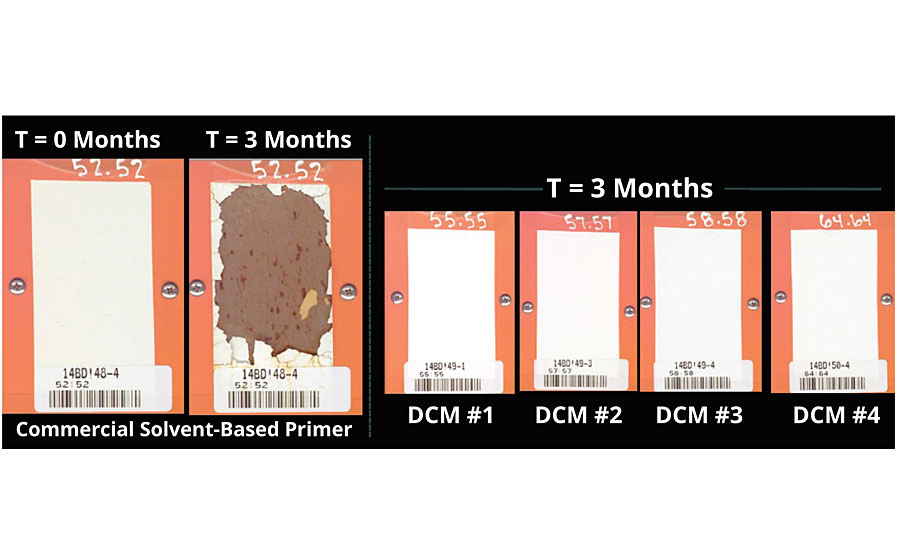
Conclusions
Primers are important in the paint industry since they help the topcoats’ ability to beautify and protect. One of the main jobs of a primer is stain blocking, including tough stains such as tannins, water damage, smoke and pet stains. Oil-based primers have dominated the stain-blocking primer market since they inherently block out stains at the substrate/primer interface. However, they typically have high VOC levels, strong odor, messy clean up and poor performance in other areas, such as corrosion resistance.
The primer market has turned to waterborne technology with the same stain-blocking abilities as the solvent-based systems. The mechanism to hide the stains, however, is different in a waterborne system as the stains are solubilized in the primer film and thus must be “locked” in place. A topcoat or two is then required to hide the stain. The use of ZnO in a waterborne primer formulation can help with stain blocking, however formulating with it does not come without tradeoffs and it is not an environmentally friendly raw material. Dow has developed a next-generation waterborne primer binder that can be formulated into a primer with excellent stain blocking without use of ZnO.
As demonstrated by the real-world exposures presented in this article, use of a primer is very beneficial over even the most challenging substrates. In some cases, the lifetime of the topcoat can be extended by over three years when a primer is used. Unfortunately homeowners do not always want to take the time to add an extra step into their paint jobs, but the end benefits outweigh the extra time needed to prime before painting.
References
1 www.arb.ca.gov/coatings/arch/spsu_final_report_may_2012.pdf
2 US 8691907 by Gebhard; Waterborne Primer.
3 US 20100047598 by Sullivan; Coating Compositions and Blocking Tannin Migration and Coated Substrate.
4 EP 407085 by Van Rheenen; Cationic Latex Compositions as Substitutes for Solvent-Based Alkyd Primers.
5 46 Pigment Volume Concentration (PVC)/37 Volume Solids (VS), ~50 g/L VOC.
This paper was presented at the 2018 Waterborne Symposium in New Orleans.
Looking for a reprint of this article?
From high-res PDFs to custom plaques, order your copy today!




